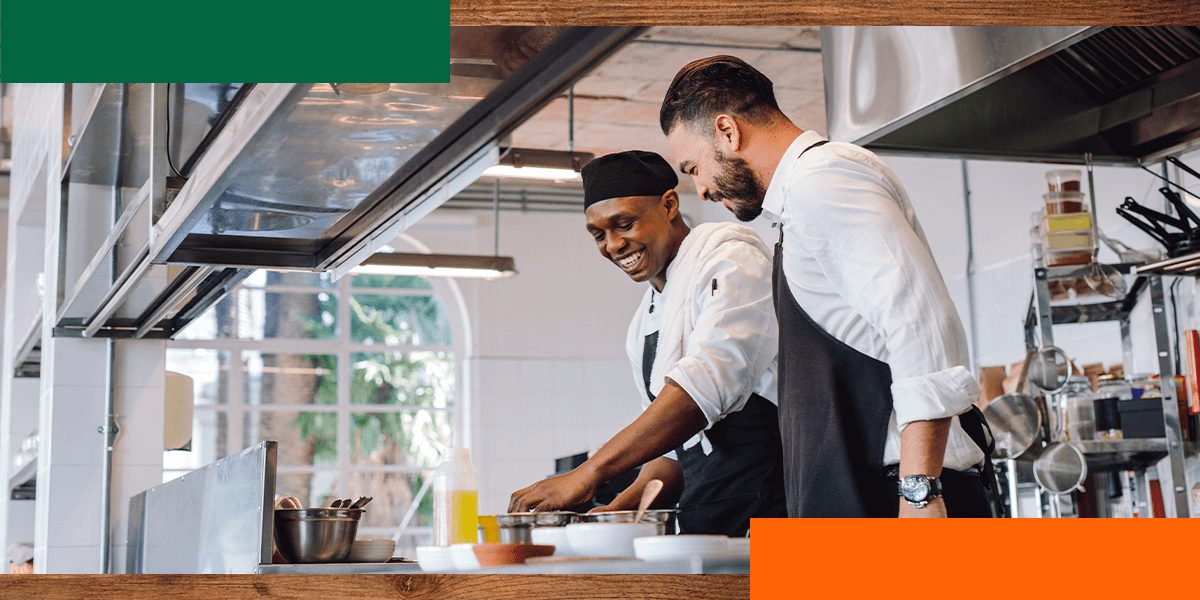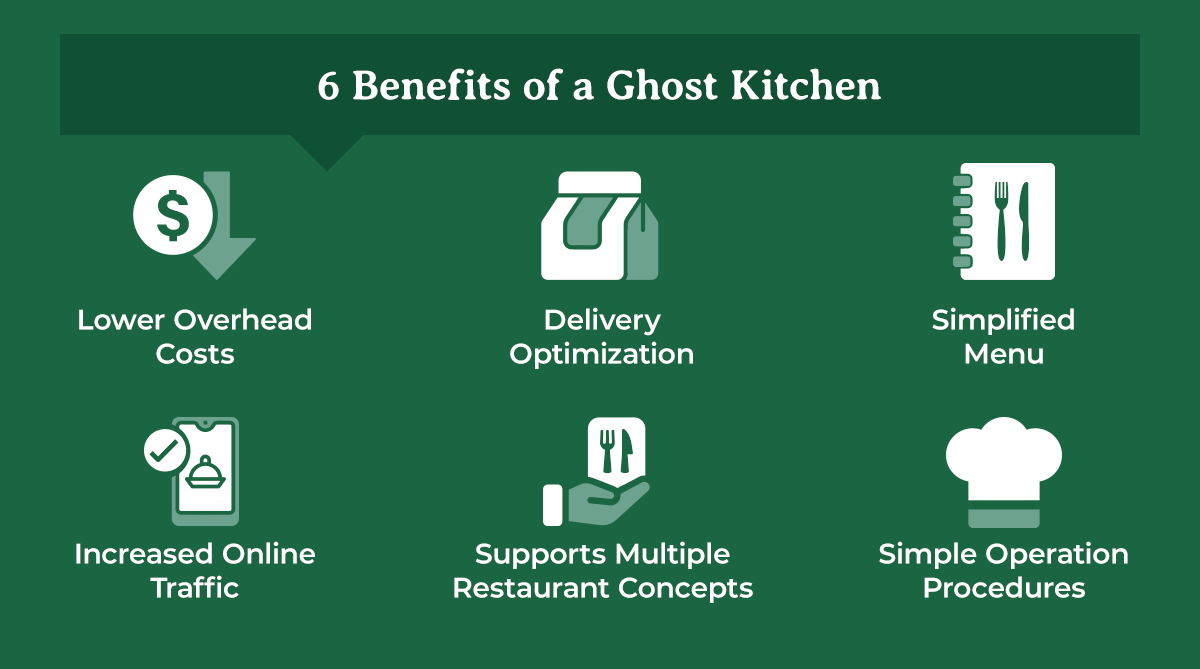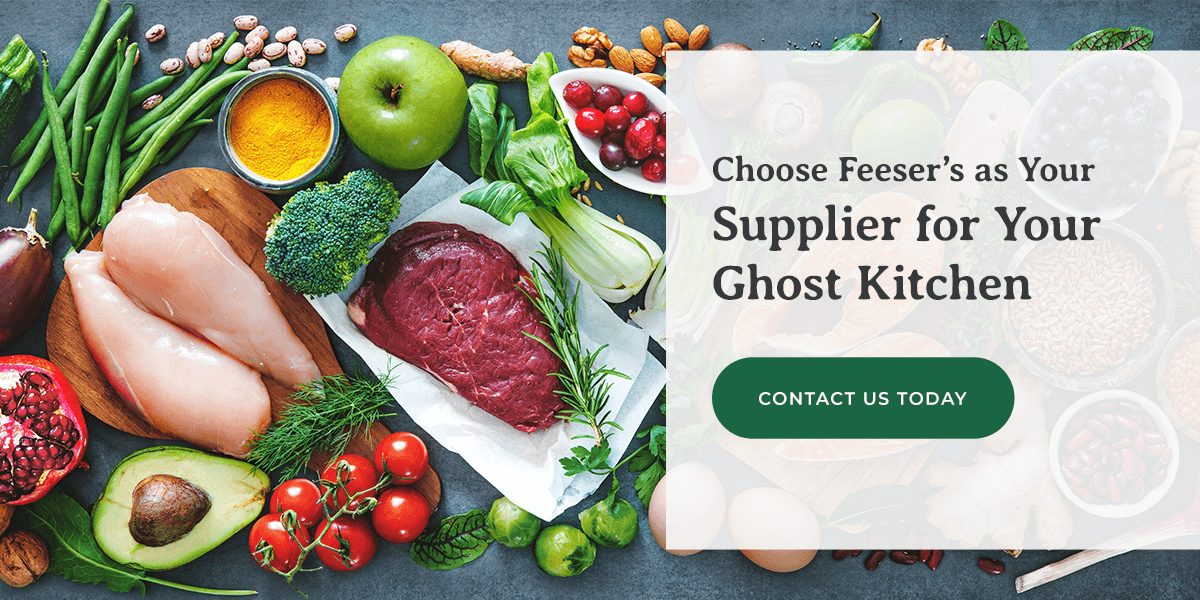What is a Ghost Kitchen?
While the term “ghost kitchen” or “ghost restaurant” may seem like the plotline of a cooking horror movie, there’s nothing scary about its reality. Ghost kitchens are a relatively new concept that is becoming increasingly popular to meet the growing appetite for food delivery services.
What Is the Ghost Kitchen Concept?
Also called a “dark kitchen” or “micro-cloud kitchen,” a ghost kitchen is a remote space that a restaurant may rent to cook delivery and takeout orders exclusively. Think of a ghost kitchen as a coworking space for restaurants. While some ghost restaurants allow takeout meals or drive-thru pickup, most do not have an actual storefront or seating for customers. Access to a ghost kitchen allows restaurant operators the space and equipment they need to prepare and deliver meals at a lower cost than a physical restaurant location.
Other types of businesses may use ghost kitchens to run their services. Some examples include:
- Caterers: Catering companies often use ghost kitchens to prepare high-volume food, ensuring compliance and efficiency.
- Food trucks: A food truck might use a ghost kitchen as a central production point to simplify its operations.
How Do Ghost Kitchens Work?
Similar to a physical restaurant, customers can view the menu of a ghost kitchen, place an order and pay for their food online. After a customer places an order, the ghost kitchen staff receives a notification and begins preparing the food. Once the food is ready, a delivery driver for the restaurant or a third-party delivery service transports the meal to the customer.
When ordering food on delivery apps, the listings for ghost kitchens will look the same as those for brick-and-mortar restaurants. Many ghost restaurants launch their brands online across multiple delivery apps to reach more hungry customers.
What Is the Difference Between a Ghost Kitchen and a Virtual Restaurant?
A virtual restaurant is delivery-only and operates within a traditional restaurant to provide additional opportunities for profits. Virtual restaurants do not increase overhead costs, such as rent and labor, since they use the existing brick-and-mortar establishment’s kitchen to create delivery-only exclusive menu items for customers.
6 Benefits of a Ghost Kitchen
Ghost kitchens are ideal for chefs and restaurant entrepreneurs who lack access to physical restaurants. Established independent and chain restaurants can also use a ghost kitchen to reach a larger customer base without building a new restaurant location. Some additional benefits of ghost kitchen businesses include:
1. Lower Overhead Costs
Juggling in-person dining orders and delivery can complicate efficiency in a brick-and-mortar restaurant. Ghost kitchens are optimized for delivery to cut unnecessary costs. Since you are only paying for kitchen space and chefs, rent and labor costs are much lower, and you can serve more customers to increase profits — compared to traditional brick-and-mortar restaurants, ghost kitchens can reduce operating costs by up to 50%, yielding significant savings.
2. Delivery Optimization
Establishing a ghost kitchen will help you streamline orders into one place. Increasing order efficiency is especially helpful if you partner with multiple delivery apps, as it gives your restaurant access to accurate customer data.
Ghost restaurants also allow you to create on-site fulfillment teams, ensuring each order gets into the hands of the correct delivery drivers and customers. With quicker cooking and delivery times, you can grow your online presence and expand into new neighborhoods to serve more hungry customers.
3. Simplified Menu
Many brick-and-mortar restaurants will make their entire menu available for delivery. In ghost kitchens, you have simplified menu items that can be packaged and transported nicely, as the main goal, after all, is efficiency.
This simplified menu speeds up food preparation. In turn, you can better focus on quality control, and inventory management is more accurate. A focused menu also helps you build a stronger brand identity. Customers know exactly what you specialize in, making it easier for them to remember and recommend your business.
4. Increased Online Traffic
In a traditional restaurant, your location is a prime factor in your success. However, foot traffic is no longer in the equation with a ghost kitchen. Instead of relying on a physical storefront to attract customers, you can focus your efforts online to develop higher order volume.
Online ordering also allows you to access a wealth of data about your customers and in-demand items, enabling you to optimize your menu and ordering needs. This insight into your customers’ ordering habits also means you waste less time and ingredients for greater efficiency.
5. Supports Multiple Restaurant Concepts
With a ghost kitchen, multiple restaurants can operate within one kitchen space. This versatility allows ghost restaurants to support multiple menus and brands without the need for additional equipment or staff. Restaurants with overlapping menus and ingredients can function in the same ghost kitchen to further save on food costs.
6. Simple Operation Procedures
With in-house dining removed from the restaurant equation, daily operations become simplified. While delivery is still a new feature for some businesses, partnering with a third-party app will take the burden of actual delivery off your shoulders so you can focus on cooking and preparing orders.
The Evolution of Ghost Kitchens
We’ve now seen the increase in chatter around ghost kitchens and their impact. This industry is expected to grow exponentially in the future. It is projected to reach $157.26 billion globally by 2030. Additionally, ghost kitchens will likely hold a 50% share of the takeaway food service and drive-thru markets worldwide by 2030.
Impact of Ghost Kitchens on the Food Service Industry
Across the globe, the food delivery industry continues to grow considerably. As this sector expands, ghost restaurants have also scaled to meet heightened consumer demand. Ghost kitchens have elevated the food service industry in the following ways:
1. Helping Restaurants Survive
Many restaurants fail to survive their first year of business. Due to rolling lockdowns from the COVID-19 pandemic, numerous eateries turned to delivery services to keep their doors open, further cementing ghost kitchens’ use and popularity.
Running a ghost kitchen allows restaurants to continue giving their customers great dining experiences in the comfort of their own homes. As many traditional restaurants enter the ghost kitchen market, they improve their chances of surviving and thriving.
2. Competition With Smaller Eateries
While creating a ghost kitchen can spell success for many restaurants, it can also be the tipping point for smaller establishments that can’t afford this service.
Ghost kitchens are quick, cost-effective and efficient. As such, some small, local restaurants that lack the staff needed to create and deliver orders quickly may find it hard to keep up with ghost kitchen businesses.
3. Opportunities for Experimentation
Since ghost restaurants are relatively safe and low-cost, chefs can experiment with new menus and dishes without worrying about losing a large amount of revenue.
Whether a restaurant has a brick-and-mortar location or uses the ghost kitchen concept, staying fresh and on-trend is the best way to capture customers’ attention and stay ahead of the market. With a ghost kitchen, chefs can easily develop a unique brand while delivering high-quality food.
How to Start a Ghost Kitchen
Starting a ghost kitchen is a great way to enter the food service industry with lower overheads. Here are some simple steps to get you started once you decide on what food you will serve:
- Find a kitchen space: Lease space in a commercial kitchen, whether it’s on an hourly or monthly basis.
- Set up delivery platforms: Partner with food delivery services like DoorDash, Grubhub or Uber Eats, as these platforms will help you reach customers.
- Get your permits: You’ll need to obtain the necessary licenses and permits, such as a business license, food service license, employee health permit and seller’s permit.
- Track and adapt: Focus on your customer feedback and sales trends. Adapt your menu or operations to keep sales and performance up.
What’s the Cost of Running a Ghost Kitchen?
Ghost kitchen startup costs are up to 45% lower than those of a traditional restaurant. It will often cost between $20,000 and $60,000 to set up. These expenses include your commercial kitchen rental, insurance, utilities, marketing costs, food costs and labor costs. You will also need to invest in disposable packaging like containers, napkins and utensils.
Choose Feeser’s as Your Supplier for Your Ghost Kitchen
Ghost kitchens offer an exciting opportunity to enter the food industry without the high costs of running a traditional restaurant. Whether you own your ghost kitchen independently or run it as an extension of a brick-and-mortar restaurant, one of the best ways to maintain happy, hungry customers is by making high-quality meals.
Since founding Feeser’s over 100 years ago, we’ve helped connect restaurants with local and national brands to ensure each ingredient meets your high standards. We stock over 8,000 items — from locally sourced produce, seafood and fresh-cut meats to national brands. This wide variety of options means that whatever your ghost kitchen needs, we can supply it. We are committed to your business’s success. We have a ServSafe® certified instructor on staff who can help you with food safety training.
To learn more about our products or services, call 1-888-326-3485 or complete our contact form today!
Content provided in part by UniPro® Foodservice



